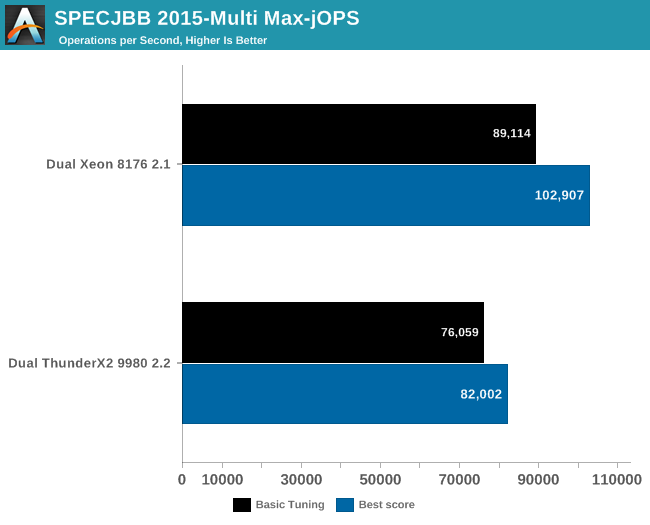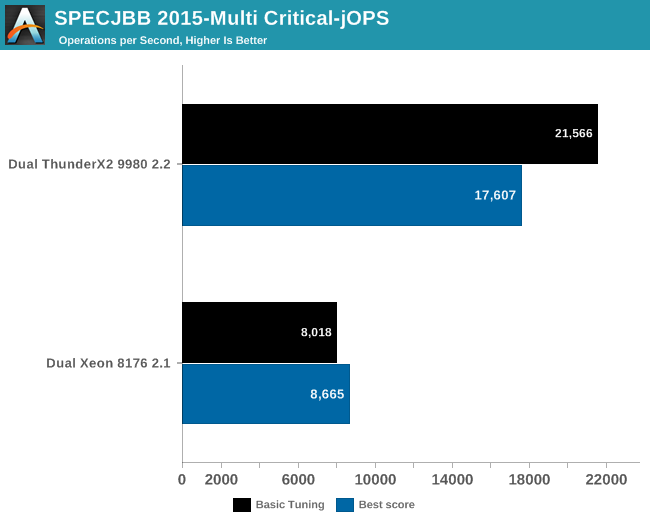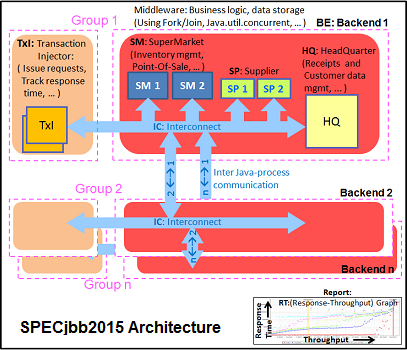Assessing Cavium's ThunderX2: The Arm Server Dream Realized At Last
by Johan De Gelas on May 23, 2018 9:00 AM EST- Posted in
- CPUs
- Arm
- Enterprise
- SoCs
- Enterprise CPUs
- ARMv8
- Cavium
- ThunderX
- ThunderX2
Java Performance
The SPECjbb 2015 benchmark has "a usage model based on a world-wide supermarket company with an IT infrastructure that handles a mix of point-of-sale requests, online purchases, and data-mining operations." It uses the latest Java 7 features and makes use of XML, compressed communication, and messaging with security.
Note that we upgraded from SPECjbb version 1.0 to 1.01.
We tested SPECjbb with four groups of transaction injectors and backends. The reason why we use the "Multi JVM" test is that it is more realistic: multiple VMs on a server is a very common practice, especially on these 100+ threads servers. The Java version was OpenJDK 1.8.0_161.
Each time we publish SPECjbb numbers, several people tell us that our numbers are too low. So we decided to spend a bit more time and attention on the various settings.
However, it is important to understand that the SPECJbb numbers published by the hardware vendors are achieved with the following settings, which are hardly suitable for a production environment:
- Fiddling around with kernel settings like the timings of the task scheduler, page cache flushing
- Disabling energy saving features, manually setting c-state behavior
- Setting the fans at maximum speed, thus wasting a lot of energy for a few extra performance points
- Disabling RAS features (like memory scrub)
- Using a massive amount of Java tuning parameters. That is unrealistic because it means that every time an application is run on a different machine (which happens quite a bit in a cloud environment) expensive professionals have to revise these settings, which may potentially cause the application to halt on a different machine.
- Setting very SKU-specific NUMA settings and CPU bindings. Migrating between 2 different SKUs in the same cluster may cause serious performance problems.
We welcome constructive feedback, but in most production environments tuning should be simple and preferably not too machine-specific. To that end we applied two kinds of tuning. The first one is very basic tuning to measure "out of the box" performance, while aiming to fit everything inside a server with 128 GB of RAM:
For the second tuning, we went searching for the best throughput score, playing around with "-XX:+AlwaysPreTouch", "-XX:-UseBiasedLocking", and "specjbb.forkjoin.workers". "+AlwaysPretouch" zeroes out all of the memory pages before starting up, lowering the performance impact of touching new pages. "-UseBiasedLockin" disables biased locking, which is otherwise enabled by default. Biased locking gives the thread that already has loaded the contended data in the cache priority. The trade-off for using biased locking is some additional bookkeeping within the system, which in turn incurs a small performance hit overall if that strategy was not the right one.
The graph below shows the maximum throughput numbers for our MultiJVM SPECJbb test.

The ThunderX2 achieves 80& to 85% of the performance of the Xeon 8176. That should be high enough to beat the Xeon 6148. Interestingly, the top scores are achieved in different ways between the Intel and Cavium systems. In case of the Dual ThunderX2, we used:
Whereas the Intel system achieved best performance by leaving biased locking on (the default). We noticed that the Intel system – probably due to the relatively "odd" thread count – has a slightly lower average CPU load (a few percent) and a larger L3-cache, making biased locking a good strategy for the that architecture.
Finally, we have Critical-jOPS, which measures throughput under response time constraints.

With this many threads active, you can get much higher Critical-jOPS by significantly increasing the RAM allocation per JVM. However, it really surprising to see that the Dual ThunderX2 system – with its higher thread count and lower clockspeed – has a much easier time delivering high throughputs while still keeping the 99th percentile response time under a certain limit.
Increasing the heap size helps Intel to close the gap somewhat (up to x2), but at the expense of the throughput numbers (-20% to -25%). So it seems that the Intel chip needs more tuning than the ARM one. To investigate this further, we turned to "Transparant Huge Pages" (THP).











97 Comments
View All Comments
Eris_Floralia - Wednesday, May 23, 2018 - link
The L2$ for SKX should be 1MB (256+768KiB), 16-way.Ryan Smith - Wednesday, May 23, 2018 - link
Right you are. Thanks!danjme - Wednesday, May 23, 2018 - link
Mental.Duncan Macdonald - Wednesday, May 23, 2018 - link
The CPU may be much cheaper than the equivalent Intel CPU - however on the price of a complete server there would be almost no difference as the vast majority of the price of a server is in other items (RAM, storage, network, software etc). To take a significant share, the performance needs to be better than Intel CPUs on both a per thread and a per socket basis. Potential users will look at this CPU - see that it is not faster than Intel on a per thread basis and is also not X86-64 compatible and turn away with a shrug. A price difference of under 5% for a complete server is not enough to justify the risks of going from x86-64 to ARM.BurntMyBacon - Thursday, May 24, 2018 - link
Perhaps you are correct and the lack of per thread performance will not allow Cavium to take a "significant' share of the market from Intel. However, at this point, getting even a small amount of market penetration in the server market is a significant achievement for an ARM vendor. This processor doesn't need to take a "significant" share from Intel to be successful. It just needs to establish a solid foothold. Given the data, I think it has a good chance of succeeding in that.The bigger question in my mind is how Intel will respond. They already have the ability to make a many lite core accelerator as demonstrated by the Xeon Phi line. Will they bring this tech to their CPU lineup, create a new accelerator based on this tech to handle applications that use many light threads, create a new many small core CPU based on Goldmont Plus (or Tremont), or will they consider the ARM threat insignificant enough to ignore.
boeush - Wednesday, May 23, 2018 - link
"(*) EPYC and Xeon E5 V4 are older results, run on Kernel 4.8 and a slightly older Java 1.8.0_131 instead of 1.8.0_161. Though we expect that the results would be very similar on kernel 4.13 and Java 1.8.0_161"What about Spectre/Meltdown mitigation patches? Were they in effect for 'older' results?
boeush - Wednesday, May 23, 2018 - link
To elaborate: if those numbers really are from July 2017, then they don't reflect true performance in a server context any longer (servers are where Spectre/Meltdown patches would be applied most.). Since the performance impact of Spectre/Meltdown is greatest on speculative execution and memory loads/prefetching, I'd guess those super-aggressive memory subsystem performance numbers, as well as single thread IPC advantages that Intel's CPUs claim in your benchmarks, are not really entirely applicable any longer.HStewart - Wednesday, May 23, 2018 - link
Spectre has been proved to effect other CPU's than Intel and even effects ARM and AMD.,Image on this article states that this CPU supports Fully Out of Order execution. So with my understanding of Spectre that this CPU also has issues.
To be honest I not sure how much the whole Spectre/Meltdown stuff is in this real world. It probably cause more harm in the computer industry than help.
Manch - Thursday, May 24, 2018 - link
Commentor: Blah Blah Blah Spectre?HStewart: Shill Shill Shill must defend Intel by any means...
lmcd - Thursday, May 24, 2018 - link
Commentor: reasonable position takenManch: *banned for unreasonable, offensive comments*